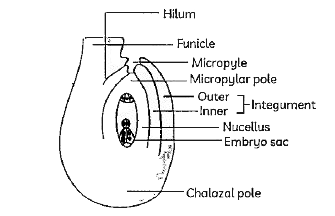Ovules generally differntiate a single megaspore mother cell(MMC) in the
micropylar region
chalazal region
near raphe
near placenta
The correct Answer is:A
Step-by-Step Solution:
1. Understanding Ovule Structure: Begin by recognizing that ovules are the structures within seed plants that develop into seeds after fertilization. Each ovule typically contains a single megaspore mother cell (MMC).
2. Identifying the MMC Location: The megaspore mother cell is located in a specific region of the ovule. In this case, we are focusing on an ananthropous ovule, which is a type of ovule characterized by its orientation and structure.
3. Defining Key Regions of the Ovule: In an ananthropous ovule, there are distinct regions:
- Micropilar Region: This is the region where the ovule opens and is crucial for fertilization.
- Chalazal Region: This is the opposite end of the micropile.
- Raffae: A structure that connects the ovule to the placenta.
4. Identifying the Egg Apparatus: The egg apparatus consists of the egg cell and two synergids, which are located near the micropile. The antipodal cells are found at the opposite end of the ovule.
5. Determining the Fate of Cells: During the development of the ovule, the synergids and antipodal cells eventually degenerate, leaving behind the egg cell, which is crucial for fertilization.
6. Conclusion: Since the MMC is located in the micropilar region of the ovule, we conclude that the ovule differentiates a single megaspore mother cell in the micropile region.
Final Answer: The ovules generally differentiate a single megaspore mother cell (MMC) in the micropile region.
---
- Micropilar Region: This is the region where the ovule opens and is crucial for fertilization.
- Chalazal Region: This is the opposite end of the micropile.
- Raffae: A structure that connects the ovule to the placenta.
Similar Questions
Megasporogenesis is defined as the process of formation of megaspores from the megaspore mother cell (MMC). MMC is a diploid cell This process occurs inside the nucellus of the developing ovule.

Ovules generally differentiate a Megaspore mother cell/s in the micropylar region of the nucellus.
View SolutionIf the endosperm of an angiosperm has 24 chromosomes, what would be the number of chromosomes in the megaspore mother cell of the same plant ?
View Solution
Knowledge Check
Read the following statements and find out the incorrect statements.
a. Ovules generally differentiate single megaspore mother cell (MMC) in the chalazal region of the nucellus.
b. The MMC undergoes reduction division and produces four megaspores.
c. In a majority of angiosperms, one of the megaspore is degenerated while the other three remains functional.
d. The nucleus of the functional megaspore divides mitotically three times and form 2-nucleate, 4-nucleate and later 8-nucleate stages of the embryo sac.
e. These mitotic division are strictly free nuclear, that is, nuclear division are immediately follwed by cell wall formation.Aa, b and cBb, c and dCc, d and dDa , c and eMegaspore mother cell originates from :
ASuperficial layer of nucellusBHypodermal cell of nuclellusCInner layer of integumentDOuter layer of integumentMeiosis of megaspore mother cell generally produces
ALinear tetradBTetrahedral tetradCDecussate tetradDIsobilateral tetrad.
Select the incorrect statement about megaspore mother cell.
View SolutionThe megaspore mother cell is differentiated from one of the cells od the
View SolutionThe megaspore mother cell is differentiated from one of the cells of the
View SolutionHow many of the daughter cells obtained from a megaspore mother cell result in the formation of monosporic embryo sac?
View SolutionWhat would be number of chromosomes in aleurone layer if megaspore mother cell contains 10 chromocomes
View Solution
